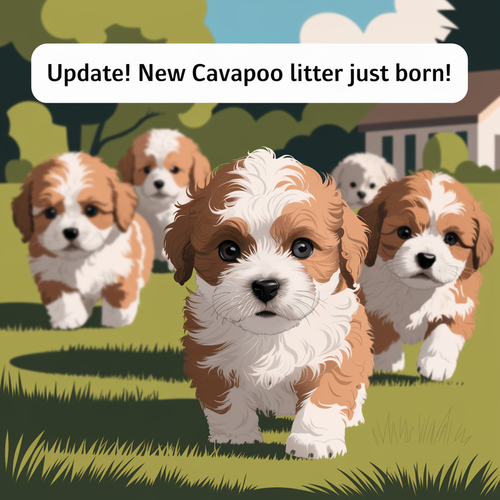
How Big Will My Puppy Get When He/She Is Full Grown?
Why Estimating Full Grown Size Can Be Tricky
One of the most common questions we get from new puppy owners is, "How big will my puppy get when they are full grown?" It’s a natural question—after all, understanding how big your furry friend will become helps you prepare for their future needs, from the size of their bed to the amount of food they’ll need. While we’re always happy to provide an estimate, there are several factors that make it impossible to predict an exact full-grown weight.
A puppy’s adult size depends on a combination of genetics, breed, and even gender. The size of the dam and sire (mother and father) can give a helpful indication, but other factors like growth spurts or the individual puppy’s characteristics can result in some surprises. This is why we always emphasize that any weight prediction is just an estimate, not a guarantee.
Let’s explore some of the key factors that can influence how big your puppy will get.

Factors That Influence a Puppy’s Full Grown Size
Dam and Sire Weight as Indicators
One of the best ways to estimate how big your puppy will get is by looking at the weights of the dam and sire. The parents' size is usually a strong indicator of how large—or small—your puppy will grow. For example, if both parents are on the larger end of the spectrum for their breed, it’s likely that your puppy will grow to be on the larger side as well.
However, it’s important to remember that this isn’t always exact. While genetics play a big role, there can still be variations in litter size and growth patterns. This is why even within the same litter, some puppies may turn out bigger or smaller than their parents.
Breed-Specific Growth Patterns
Different breeds grow at different rates, and this also impacts how large your puppy will be when fully grown. Smaller breeds like Maltipoos and Miniature Poodles often reach their adult size more quickly than larger hybrid breeds like Cockapoos. Knowing your puppy’s breed can give you a good idea of when their major growth spurts will happen and when they’re likely to reach their full size.
If you have a hybrid breed like a Cavapoo or Cockapoo, the size and characteristics of both parent breeds come into play, making the estimate a little more complicated—but still manageable with a good understanding of their typical size ranges.
Litter History and Gender
The weights of previous litters from the same parents can also provide useful insight into your puppy’s potential size. If a previous litter produced puppies that all ended up around the same weight, it’s likely that the current litter will follow a similar trend.
Additionally, gender can play a role. In many cases, male puppies tend to be slightly larger than female puppies when fully grown. However, there are always exceptions, and sometimes a smaller male might grow larger than expected due to a growth spurt.
Estimating the Size of Each Breed We Raise
At Weaver Family Farms, we specialize in several breeds, each with its own typical full-grown size range. While we can provide an estimate based on breed averages and the parents’ sizes, it’s important to remember that individual puppies can still vary. Here’s a general guide to the expected full-grown size for each breed we raise.
Miniature Poodles
Miniature Poodles are one of the smaller breeds we occasionally raise. When fully grown, Miniature Poodles typically weigh between 10 and 15 pounds. This small-to-medium size makes them a great option for families who want a dog that’s easy to manage but still has plenty of energy.
Cockapoos
Cockapoos, a cross between a Cocker Spaniel and a Poodle, tend to have a bit more variation in their size depending on the size of the Poodle parent. On average, Cockapoos will weigh between 16 and 24 pounds when full grown. They’re medium-sized dogs that offer a great balance between being active and cuddly.
Cavapoos
Cavapoos, a mix of a Cavalier King Charles Spaniel and a Poodle, usually grow to be 14 to 20 pounds as adults. Their size makes them an excellent companion for both apartment living and active households. Cavapoos are known for their gentle nature and adaptability, making them a popular choice.
Maltipoos
Maltipoos are on the smaller side, typically weighing 10 to 14 pounds when fully grown. This hybrid breed is a mix of a Maltese and a Miniature Poodle, and their small size, combined with their playful nature, makes them a great option for families looking for a smaller dog.
While these size ranges are helpful, remember that every puppy grows at their own pace. These estimates give you an idea of what to expect, but surprises can happen! For more advice on caring for your new puppy, be sure to explore our guide on How to Train a Cockapoo Puppy.
The 8-Week Weight Estimate Formula
One simple yet effective way to estimate how big your puppy will get is to use the 8-week weight estimate formula. This method gives a rough idea of your puppy’s future size by multiplying their 8-week-old weight by three. While it’s not foolproof, it offers a reasonable estimate based on the puppy’s growth during the early stages of life.
How to Use the 8-Week Weight Estimate
Here’s how it works:
- Take the puppy’s weight at 8 weeks old, then multiply that number by three.
- For example, if your puppy weighs 5 pounds at 8 weeks, you can expect them to be around 15 pounds when fully grown, assuming their growth continues at the same rate.
Limitations of the Formula
While this formula is helpful, it’s important to remember that puppies grow at different rates, and some breeds or individual puppies may experience growth spurts or periods of slower growth. This method works best for smaller to medium-sized breeds but may be less accurate for larger breeds or puppies with unpredictable growth patterns.
It’s a great starting point for families curious about their puppy’s size but should be used alongside other factors, like the size of the parents and the breed’s typical weight range.
For more tips on raising your puppy, check out our guide on Helping Your Dog Adjust to a New Home.
How We Estimate Puppy Size at Weaver Family Farms
At Weaver Family Farms, we understand how important it is for families to have an idea of how big their puppy will be once fully grown. While we can’t guarantee an exact weight, we use a combination of factors to provide the best possible estimate.
Our Process for Giving Size Estimates
When offering an estimate, we look at the weight of the dam and sire as our primary guide. Additionally, we factor in the size trends from previous litters. If past puppies from the same parents have consistently fallen within a certain weight range, we use that information to give you a better idea of what to expect.
We also observe the puppy’s growth pattern early on. By 8 weeks, we can apply the 8-week weight estimate formula to help project their full-grown size. However, we always remind families that puppies can grow at different rates, and a final weight is never something we can promise.
Transparency in Size Predictions
At Weaver Family Farms, transparency is key. We never want to mislead you with size guarantees. We prefer to give realistic expectations based on the factors we’ve observed while making it clear that growth spurts or smaller-than-expected results can occur. Our goal is to make sure you’re prepared for any surprises, while providing as accurate an estimate as possible.
For more advice and insight into raising your new puppy, feel free to explore our Tips & Information blog.
How We Estimate Puppy Size at Weaver Family Farms
At Weaver Family Farms, we always aim to provide families with the best possible estimate of how big their puppy will be when fully grown. Our process for giving these estimates is based on a combination of factors, including the size of the parents, breed characteristics, and even the weights of previous litters.
While we can offer a general idea of the size range your puppy may fall into, it’s important to remember that no estimate can be 100% accurate. Puppies, just like people, have individual growth patterns that can sometimes surprise us! For example, some puppies that start out small may experience a growth spurt later on, while others may remain smaller throughout their development.
Transparency in Size Predictions
As breeders, we pride ourselves on transparency. We’ll always give you the most accurate size estimate based on the information we have, but we want to be clear that we can’t promise an exact adult weight. These estimates are meant to guide you in preparing for your puppy’s future needs without misleading you.
Ultimately, our goal is to set realistic expectations while ensuring that your puppy is raised with love and care. If you have any questions about your puppy’s growth or if you want more information on how to care for your new furry family member, feel free to reach out to us!
For more insights into puppy care, check out our collection of Tips & Information articles.
Estimating how big your puppy will get when fully grown can be both exciting and a little uncertain. While we do our best to provide accurate predictions based on the size of the parents, breed characteristics, and growth patterns, there’s always room for surprises. By using the general breed size guidelines, the 8-week weight estimate formula, and taking into account the unique factors that influence growth, you can get a good idea of what to expect as your puppy grows.
At Weaver Family Farms, we believe in being transparent with our families, giving you the best possible estimates while ensuring that your puppy is healthy, happy, and well cared for. As your puppy grows, enjoy each stage of their development, and feel free to reach out to us with any questions along the way. We’re always here to help!
For more tips on raising your puppy and creating a loving home, be sure to explore articles like How to Train a Cockapoo Puppy and Helping Your Dog Adjust to a New Home.













